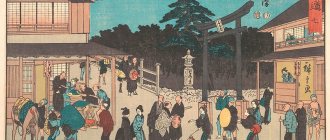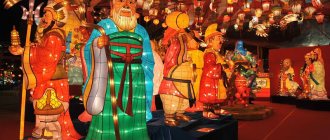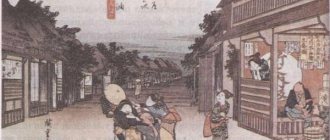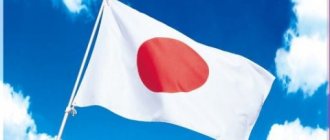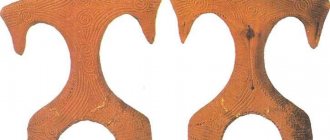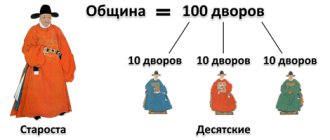Social and government system of medieval Japan
ABSTRACT
on the history of state and law of foreign countries
on the topic: “The social and state system of medieval Japan”
TABLE OF CONTENTS
Introduction………………………………………………………………………………3
1. Social system of medieval Japan…………..………………………4
2. The government system of medieval Japan…………………….…..………6
Conclusion………………………………………………………………………………….10
List of sources used………………………………………………………11
INTRODUCTION
In the 3rd century. In Japan, the process of decomposition of the primitive communal system began. Within clans, a clan aristocracy stands out, property and social inequality develop, and various forms of exploitation by the privileged clan elite of their relatives and foreigners captured during wars develop. Slave forms of exploitation, which contributed to the strengthening of the socio-economic and political positions of the clan nobility, did not, however, become widespread. The geographical conditions of Japan, its island position, and mountainous terrain constrained their development. Here it was impossible to create large latifundia with primitive tools (since irrigated rice cultivation required intensive peasant labor on a small plot of land), and also to obtain a sufficient number of slaves through military campaigns.
Not the least role was played by the special influence of the highly developed Chinese civilization, with its traditional socio-economic structure and state system, as well as religions: Buddhism and Confucianism, which was especially strong in the early stages of the development of Japanese society and the state. Speaking about the strong religious influence of China, it should be noted that of the two Chinese religions (Confucianism and Buddhism), the influence of Confucianism was superficial. It did not take deep roots in Japan in comparison with the easily digestible Buddhism, since at the time of its penetration there had not formed a sufficiently educated layer of religious ideologists capable of introducing its philosophical dogmas to the masses.
From the 4th century Tribal unions were formed in Japan, and in the 5th century. the leader of the Yamato tribal union unites most of the country's territory under his supremacy.
To intensify the processes of social stratification in the 6th century. and the formation of the state apparatus in Japan was greatly influenced by the long struggle of individual clans for supremacy in the tribal union and the victory of one of them, led by Shotoku-taishi, during whose reign the first legislative document appeared, the first declaration of the kings of Yamato - the Shotoku Constitution, or the Law of 17 articles (604), which determined the principles of public administration.
Being not so much political and legal provisions as the religious and ethical basis of such provisions, the Law of 17 articles advocates agreement, harmony, service to the common, not the personal, of all Japanese. At the same time, their inequality is directly consolidated, the ruler is especially singled out, then the nobles and the common people. The ruler is considered as a single sovereign, the nobles are his officials, and the people are the mass of people subordinate to them (Article 15) [1, p. 367].
1. SOCIAL SYSTEM OF MEDIEVAL JAPAN
From the 4th century Tribal unions were formed in Japan, and in the 5th century. the leader of the Yamato tribal union unites most of the country's territory under his supremacy.
The socio-economic innovations of this time were reflected in a series of reforms enshrined in the Taika Manifesto, supplemented by a special code “Taiho ryo” (“Code of Taika Laws” (code “Taiho ryo”), which summarized all legislative acts of this period from 646 to 700, saw light in 702.
Land plots, allotments subject to redistribution every six years, were distributed among full-fledged peasants (remins) according to the number of eaters. Slaves also received an allotment equal to a third of the free allotment. The state, as the owner of the land, provided for triple duties of the peasants: rent (to give) in grain, tax on handicraft products and labor duty, lasting up to a hundred or more days a year [3, p.242].
The introduction of allotment systems in Japan did not mean, however, an equal redistribution of land. A significant part of the land passed into the hands of officials (replenished by the same nobility) as official official allotments, the size of which depended on position and rank. The nobility received some lands for lifelong use, sometimes with the right to inherit the land in a straight line, from one to three generations
Further feudalization of Japanese society led to the collapse of the allotment system. Periodic redistribution of land actually ceased in the 10th century, when the allotment system was replaced by a privately owned estate (shoen), created through the expropriation of communal lands, the development of virgin lands, which were only possible for the rich community elite, numerous imperial land grants for merit, service and etc.. The formation of privately owned estates was accompanied by the gradual transformation of allotment peasants into feudal-dependent ones.
The new manorial system swept away all obstacles to the creation of large feudal land ownership, and, consequently, the political fragmentation of the country with inevitable internecine wars, stimulating the development of relations of patronage, domination and subordination, vassal-fief relations. The ranks of the emerging feudal class began to be replenished by the warriors of the rulers and large feudal lords, who received land plots as fiefs as remuneration for military service [5, pp. 174-175].
This layer of professional warriors, replenished by small landowners who sought protection from powerful landowners, turned over time into a closed class of samurai (bushi), with its own code of honor based on the cruel demand of loyalty to the master, up to the unconditional readiness to give his life for him.
From the 10th century In Japan, therefore, a feudal organization of land ownership, so unusual for the East, begins to take hold, together with the widespread development of small-peasant farming, which determines the similarity of the Japanese and Western Middle Ages.
A number of factors contributed to this. First of all, on the path to creating feudal forms of property in Japan, unlike China, an omnipotent state “with its control and regulatory functions” did not stand in the way, since an influential Confucian elite, a strong numerous corps of official administrators, together with an effectively reproducing bureaucracy is competitive - through an examination system.
The traditional dominance of large clan groups, which weakened the center and did not let go of the reins of power, also had an effect. The power of clan feudal houses, relying on their own military strength of loyal samurai, became the main reason for the long-term fragmentation of the country, the ineffectiveness of the attempts of the first shoguns (“great commanders”) in the 12th and 14th centuries. combine it. The strengthening of central power, relying on military force, occurred only during the period of the third Tokugawa shogunate (early 17th - first 19th centuries).
Long-term fragmentation, in turn, hampered the socio-economic development of Japan. The almost undivided dominance of feudal relations existed in this country until the middle of the 19th century, until the revolutionary, bourgeois in nature changes in the era called the Meiji restoration (Meiji is the official name of the years of the reign of Emperor Mutsuhito [4, p. 144].
2. GOVERNMENTAL SYSTEM IN MEDIEVAL JAPAN
Taika reforms, which were significant for Japan in the 7th century. The significance of the political revolution marked the establishment of an early feudal state led by a hereditary monarch. They were prepared by Buddhist and Confucian teachings about a single state, headed by a “monarch-sage”, a “descendant of the gods”, possessing unlimited power. The ancient Japanese religion of Shinto (“the way of spirits”), which easily absorbed the ideas of Chinese religions about the divine power of the ruler-emperor, also contributed to this,
As a result of the “Taika coup,” a unified Japanese state was created headed by the emperor, the prince of the ruling dynasty, who relied on the support of the powerful Fujiwara clan, which subsequently supplied from generation to generation not only hereditary regents-co-rulers of the emperors, but also empresses.
The ancient Japanese religion of Shinto (“the way of spirits”) assigned the ruler the role of a high priest, a divine descendant of the sun who took on human form. The synthetic religion of the Japanese “rebu Shinto” (double Shinto), which developed in the 6th-7th centuries. based on a mixture of Shinto and Buddhism, recognized in the emperor not only the spiritual head, the high priest (in this capacity, as a semi-divine person, he was the object of expressions of humility and obedience), but also a secular monarch, primarily the leader of the army, whose indisputable authority for officials was based on codes and laws. This is where the carefully developed structure of all government institutions in Japanese law originates: central and local, spiritual and secular. The 17-article law, speaking of the “divinity of the sovereign,” contained a significant clause about advisers as “a necessary condition for the correct decision of important matters.” And Shotoku-taishi, rejecting the idea of one-man rule, argued that “matters should not be decided personally by the sovereign.” Since ancient times, an adviser of any rank has become the main figure in the imperial state apparatus in Japan. And in fact, the divine “tenno”, which according to the law had the highest legislative, executive and military power, already in the 8th century. reigned more than ruled under the powerful Fujiwara clan, a symbol of whose omnipotence was, for example, the construction in 794 of another capital in Kyoto. At this time, the imperial residence was in Naro. Subsequently, the existence of two capitals in Japan became traditional, along with the traditional dual power and even triple power, when Buddhist hierarchs were also involved in government affairs.
Direct management functions in the secular State Council were carried out by two senior ministers: the left (senior) and the right (junior), who in turn relied on “senior advisers” who participated in the discussion of all matters and gave recommendations “on big matters,” and junior advisers, giving recommendations on “small matters”. They were the ones who monitored the progress of current affairs and were responsible for them before the State Council. The State Council had eight ministries under its command [2, pp. 396-397].
Along with the military ministry, the ministries of finance and justice in Japan, there was a special ministry of “general affairs”, which was in charge of current palace affairs, ritual, editing imperial decrees, and monitored the compilation of the history of the country, lists of princes of the blood, court ladies and Buddhist clergy, as well as the general register population and tax schedule. Being, as it were, the highest office of the country, this ministry occupied the first place in the state apparatus due to the special closeness of its head to the emperor. He received reports and submitted petitions to the emperor, while maintaining connections between the State Council and other ministries.
The breadth of the functions of this ministry is evidenced by the extremely extensive staff of its ten departments, among which were the special department of the Empress's court, the main archive department, the main department of palace storerooms, the astrological department, the department of painting, and court etiquette. The activities of the latter department were closely connected with the activities of the special Ministry of Ceremonies, which was in charge not only of monitoring the observance of etiquette, but also of public schools, certification of candidates for official positions, appointment and transfer of officials, recommendations for their rewarding, issuing salaries, etc. .
In the 12th century the economic power and political influence of local clans of governors, viceroys, etc., is growing, who actually become unlimited rulers-patrimonial rulers in their domains. In the conditions of the ongoing clan struggle of various groups of the ruling class: court circles, the strongest clans, the clergy, in the 12th century. In Japan, a new form of government is being established - the shogunate, a unique form of feudal military dictatorship, in which power, both in the center and to a certain extent locally, was concentrated in the hands of the shogun - the “great commander”.
A characteristic feature of the shogunate was the retention of the emperor as the nominal head of state, with some representative functions. The emperor was given all the honors due to his rank, but neither he nor his court played any significant role in the political life of the country. From this time on, the imperial court turned into the center of feudal opposition, which became one of the many reasons for new outbreaks of internecine struggle.
However, it was not immediately possible to create a permanent political-administrative system of the shogunate, strengthen the hereditary principle of transfer of power to the shogun, and concentrate actual power in his hands, and not in the hands of his regents or deputies. Moreover, during the period of the second shogunate, the power of the bakufu was significantly weakened. This was facilitated by the fact that the Japanese shogun had to admit his vassal dependence on China, to which the right to approve the Japanese emperors passed. In the country at that time there were about 20 large and a significant number of medium and small daimyos, who actually ruled in their domains independently.
However, the centralization of Japan even at this time was of a relative nature. Feudal principalities as administrative and political units were not eliminated. Local princes retained the right of administration and court in their territories. Trade and craft in large cities, as well as mining enterprises, remained under the control of the bakufu [2, p. 398].
State and rights of Japan in the Middle Ages
When studying the topic you should:
– determine the meaning of Shintoism, the influence of China and Buddhism on medieval Japan;
– reveal the contents of the Shotoku Constitution of 604, the Taika Manifesto of 646, the Taiho-re Code of 701;
– determine the legal status of samurai according to the Bushido code;
– understand the reasons for Japan’s independence, determine the status of the emperor, the great council of state, ministers, and the ministry of central affairs;
– study the uniqueness of the seigneury system;
– determine the reasons for the triarchy and the military coup of 1185;
– consider the establishment of the shogunate;
– study the features of the Minamoto shogunate;
– assess the legal status of the shogun, tindai, bakufu, chambers (main administrative, main military, main judicial), collegiums, officials;
– consider the judicial system, the military system;
– clarify the role and significance of the Buddhist Church;
– determine the features of territorial division, the status of local governments;
– study the features of the Ashigawa shogunate;
– consider the reasons for the victory of the Tokugawa clan;
– study the formation of new classes (warriors, peasants, artisans, merchants);
– evaluate the code of laws of Taiho-ritsur, as it relates to feudal, family, criminal law, and judicial process.
State and rights of India in the Middle Ages
When studying the topic you should:
– determine the causes and conditions of political fragmentation and the emergence of principalities;
– characterize the governing bodies of the principalities (maharaja, mantriparishad, judicial system, military system), the territorial division of the principalities, determine the influence of Judaism;
– pay attention to the reasons and conditions for the establishment of the Delhi Sultanate;
– reflect the process of Islamization of society;
– assess the state system (sultan, privy council, vizier, divans, military department, financial department), territorial division;
– consider the caste division of society;
– study the causes and conditions of the Mongol conquest, characterize the Mughal Empire, the reign of Akbar, determine the significance of the adoption of the Decree on Tolerance;
– consider the political system (mansabdari system, padishah, ministers, diwans), territorial division;
– reveal the process of colonization of India by Europeans (sea route to India, East India Company);
– study Brahmin law;
– clarify the influence of Islamic law, reveal the content of nibandhas;
– determine the features of regulation of marriage and family relations, property rights, contract law, criminal law.
References used: [1, 2, 3, 4, 5, 6, 7, 8, 9, 10, 11, 12, 13, 14, 15, 21, 28, 44, 49, 52].
State and law of the Arab Caliphate
When studying the topic you should:
– determine the features of the formation of the theocratic monarchy among the Arabs and characterize this form of government;
– determine the role of Islam in the formation of the state;
– determine the political system of the Arab Caliphate, the legal status of higher and local government bodies, the army, the court;
– understand the reasons and conditions for the decentralization of power and the collapse of the caliphate in the 11th–12th centuries;
– reveal the features of the formation and development of Muslim law, determine the sources of Muslim law: Koran, Sunnah, Ijma, Fatwa, Qiyas;
– characterize the main schools of Islamic law;
– study the features of regulation of property rights, the content of the institution of waqf, the principles of regulation of contractual relations, the content of the institutions of marriage, family and inheritance law, the concept and types of crimes and punishments.
References used: [1, 2, 3, 4, 5, 6, 7, 8, 9, 10, 11, 12, 13, 14, 15, 21, 28, 44, 49, 52].
Questions for self-control
1. What is unique about the periodization of the medieval states of India and China?
2. What features of originality and similarity with European experience does medieval Chinese legislation reveal?
3. How was the medieval state governed in China and Japan?
4. How did the Mongol Empire arise and be ruled?
5. What are the features of the emergence of the state of Japan?
6. What is a form of government called the “shogunate”?
7. Which classes dominated in Japan?
8. What are the features of Japanese feudal law?
9. Which branch of law was of predominant importance for the medieval state of Japan?
10. What features of originality and similarity with European experience does medieval Japanese legislation reveal?
11. What is unique about the periodization of medieval law in China?
12. How did the formation of the Chinese feudal state take place?
13. Describe the social system of medieval China.
14. How was medieval China governed?
15. Name the dynastic codes of laws of medieval China that have survived to our time.
16. What are the features of feudal law in China?
17. Which branch of law was of predominant importance for medieval China?
18. What role did the Gupta state play in the formation of Indian statehood?
19. What was the state mechanism of the Delhi Sultanate?
20. What form of state developed in the Mughal Empire?
21. What are the features of feudal law in India?
22. What was the significance of Brahman law for the formation of medieval law in India?
23. What is the relationship between the periodization of the Arab Caliphate and the schools of Muslim jurisprudence?
24. List the main sources of Islamic law in the order of their historical origin and official recognition.
25. What influence did Islam have on the historical path of the Arab tribes?
26. Describe the social system of the Arab Caliphate.
27. What was the form of government and territorial structure of the Arab Caliphate?
28. What are the features of the government structure of the Arab Caliphate?
29. Describe the property rights and the law of obligations of the Arab Caliphate?
30. Name the main types of offenses and legal liability in Islamic law.
31. What was the judicial system like in the Arab Caliphate?
32. What is unique about marriage and family relations under Islamic law?
